AAC Core Vocabulary
Adapted Book
Build a...
Bundle
Coins
Core Vocabulary
Cut and Paste
Dollar Up
File Folders
Fill the Order
Fine Motor
FREE
Hygiene
Job Skills
Life Skills
Math
Menu Math
Money Awareness
Multi-Sensory Storytelling Kit
Neurodivergent Affirming
Phonics
Prepositions
Puberty
Puzzle
Question Words
School
Sensory Social Narrative
Ships to You
Shopping List
Shopping Lists
Sign Language
Social Skills
Task Box (Ships to You)
Uncategorized
Verbs
Wh Questions


...
$19.35 USD
$27.79 USD
Looking for a fun and engaging way to teach your child about bathroom behavior?
Look no further than Social Skills Stories Bathroom Bundle.
From toilet accidents to washing hands, this bundle has everything you need to help your child learn about appropriate bathroom behavior.
Toilet Accidents
Passing Gas
Wiping Myself
Keeping My Clothes on in the Bathroom
Public Restrooms
Washing Hands
Where Can I Pee?
Plus, save over 30% by purchasing this bundle!
With colorful photographs and simple text, these social skills stories are sure to grab your student's/child's attention and help them learn proper bathroom etiquette in a fun and entertaining way.
7 Bathroom Social Skills Stories
Editable Text
Print and bind into a book, or just read it digitally on any of your devices.
P.S. If you like this book, you may be interested in checking out our full collection of bathroom related social narratives.
Editable
Want to edit this book?
Possibly add in a student name or change a picture? 📷
You can do that now! Just click the link in the back of the book and you'll be taken to an editable version saved in google slides! 💻
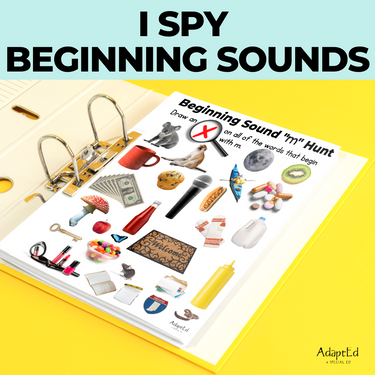
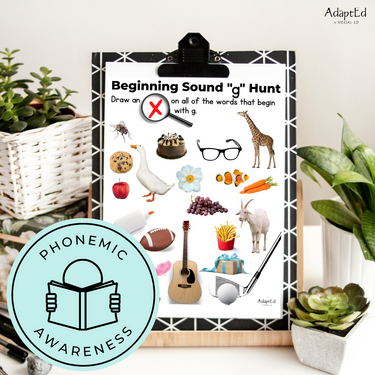
...
$3.97 USD
Is your child just starting to learn their letters and sounding out words? These I Spy Beginning Sounds mats are the perfect tool to help them gain confidence and practice letter-sound correspondence.
Each mat features real photos and corresponding letter sound to help your child make the connection between the objects and the sound it begins with.
You can use these mats in a variety of ways, including with manipulatives for a fine motor component, or laminated with dry erase markers, pompoms or playdough. The possibilities are endless!
This is a great way to build vocabulary and practice phonemic awareness.
Plus, it's NO PREP - just print and go!
25 I Spy Worksheets
This set is ideal to be used with:
Special Education
Beginning Readers
Struggling Readers
Pre-K to 1st Grade (RTI)
This is perfect for:
Literacy Centers Stations
Morning Work
Finished Bins or "I'm Finished" Work
Small Groups
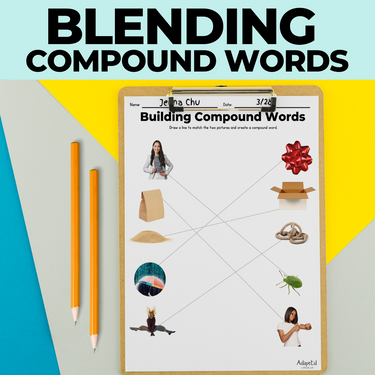
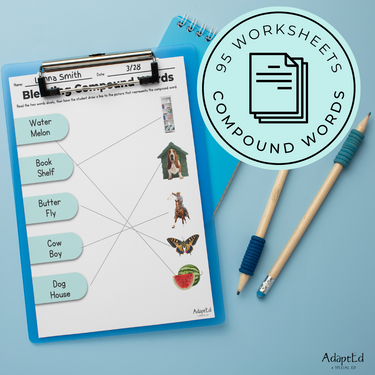
...
$5.97 USD
Blending compound words is an essential literacy skill for students with disabilities, which can greatly improve their understanding of phonemic and print awareness!
This set includes 95 worksheets, in 3 different styles to provide repetition with variety to help learners develop this ability to blend words.
Step 1: Read The teacher or instructor reads out the two words slowly, guiding the learner in repeating the word either in their head or out loud while combining the two words together.
Step 2: Blend After they have blended the word, they can then proudly circle the correct picture. (feature pictures include both individual words along with the blended compound word.)
Step 3: Evaluate If students find it difficult to understand how to combine sounds together, instructors should look out for patterns in their mistakes and model techniques that will help them understand how to blend sounds correctly.
With practice, learners can become more confident and motivated in recognizing patterns within written language, paving a path towards better reading development.
This is perfect for:
Literacy Centers Stations
Finished Bins or "I'm Finished" Work
Small Groups
Why Compound Words for Teaching Blending?
Learning to blend compound words is an integral part of literacy development for students with disabilities, as it can help build their language and sound fluency.
Teaching the skill of blending compound words provides the student with a foundation of skills that is necessary for higher order reading and comprehension tasks.
Blending compound words helps students develop both phonemic and print awareness, which is essential for success in decoding and encoding words.
With practice, the student can become more confident in their ability to recognize and recognize patterns within written language. In addition, teaching this skill gives students with disabilities an advantage in becoming independent readers.
5 Reasons Why You Should Incorporate Compound Words Into Your Reading Instruction
Compound words help beginning readers recognize and accurately blend individual sounds.
When exposed to compound words in the early stages of learning to read, students are more likely to develop strong foundational literacy skills.
Compound words provide visual cues for the learner which makes it easier for them to understand how a word is constructed and each sound pronounced.
Mastering the task of blending longer compounds words gives early readers a sense of accomplishment while learning to read.
Learning how to identify and decompose compound words in can help students memorize vocabulary better and improve spelling accuracy.


...
$3.50 USD
Includes a 14-page book that will get your students ready to successfully eat in the cafeteria. Our sensory social stories are great for students that are working on participating in all school activities.
Sensory strategies can help students cope with situations they wouldn’t be able to handle otherwise.Read these books to let students know what to expect and what strategies are available to them.


...
$7.95 USD
Get you and your students wheels turning about possible career choices...
Included in this set are 2 picture interest surveys.
The first set works best for older students.
It asks pertinent questions about life on the job.
The second career interest survey works best for younger students.
Questions are Yes/No and are more basic about likes and dislikes.
This valuable information is very helpful when brainstorming about future jobs.
PDF | 63 Pages | 56.3 MB


...
$29.99 USD
Prepare for Life Beyond School
Getting your kids ready for life beyond school is a difficult task, especially without the right resources.
You need something that will teach them real-life skills and get them career-ready, but is also more than just a jobs chart.
Our career readiness curriculum is fully customizable, as well as age-appropriate.
All wrapped up in an easy-to-implement, comprehensive system that's designed to carry your them through every aspect of career readiness.
Take a look and see why this is so much more than just some ordinary classroom jobs posters...
COMPARE US
Ours
Theirs
Step by step visual supports
✔️
✔️
Real images (no cartoons!)
✔️
❌
Social Narratives
✔️
❌
Job applications (3 levels)
✔️
❌
Interview System
✔️
❌
Paycheck System
✔️
✔️
Money handling practice
✔️
❌
Job review & feedback acceptance
✔️
❌
Employee of the Month
✔️
✔️
Editable text
✔️
❌
Workplace Vocabulary Stories
Workplace Vocabulary Stories explore words that are essential for everyday work life. Using real pictures and simplified language, these stories teach students words they will need for the rest of their lives and careers... "Paycheck" being just one of them. :)
Social Narratives
Social narratives explore social constructs, like the ever-important "handshake"- that are crucial for getting and keeping a job.
Handshake: we all know that first impressions count. Ensure that your students know the appropriate greeting for an interview or important event by teaching them with real images.
Dress for Success: Help your students to know the types of clothing that are appropriate for an interview- and WHY it matters!
Hygiene: We are helping to forge the next generation of adults. Possibly the most functional and crucial thing that we can teach our students is how to take care of their own bodies.
Knowing how to stay clean and healthy and how our hygiene affects us socially is a MUST.
Job Skills Practice
It's so important that students can begin to recognize what skills are required for a job.
This allows them to practice, prepare, identify he best jobs for them, and eventually have a deeper understanding of personal strengths.
Included:
Classroom job positions with descriptions
List of “helpful skills” to accompany each job position
Practice job applications with 3 levels of difficulty for differentiation
Interview System
Class paycheck system
Full classroom purchase/reward system included
Money handling practice
Job review system (for building self-monitoring skills, independence and feedback acceptance skills
Employee of the Month System included
18 Job/ Chores Step By Step Printable Posters


...
$5.97 USD
"The Carnivorous Plants Trilogy: Decodable Readers with a Bite!"
Unveil the thrilling and eerie world of carnivorous plants with our set of three decodable readers! These books are designed to engage even the most reluctant students with their captivating content and real-life images.
"Venus Flytrap: The Plant with a Bite!" - Embark on a journey into the fascinating world of Venus Flytraps! This reader is a treasure trove for curious students, filled with real-life images and intriguing facts about this creepy, crawly-devouring plant.
To ensure your students fully grasp the concepts, each decodable reader concludes with picture-supported multiple-choice reading comprehension questions.
"Pitcher Plants: Nature's Deadly Cup" - Delve deeper into the realm of carnivorous plants with our second installment featuring the enigmatic Pitcher Plants. Real photos and riveting hunting strategies will keep your students engrossed from start to finish.
"Sundews: The Sticky Trap" - Lastly, unravel the sticky secrets of Sundews! Our third decodable reader showcases vivid, real-life images and fun facts that will hook your students from the first page to the last.
Each book is a printable PDF and comes as a digital download file. With a total of 46 pages, each plant has its own separate decodable reader and reading comprehension questions.
Plus, we've added bonus information at the back of to extend the learning using multi-sensory storytelling techniques.
With "The Carnivorous Plants Trilogy," reading becomes an adventure that's sure to ignite curiosity and wonder in every student!


...
$3.50 USD
Includes a 12-page book that will get your students ready to successfully join in circle time. Our sensory social stories are great for students that are working on participating in all school activities.
Sensory strategies can help students cope with situations they wouldn’t be able to handle otherwise.Read these books to let students know what to expect and what strategies are available to them.


...
$29.97 USD
10 Color Hunt Worksheets
These Color Hunt Worksheets are perfect for students who want to improve their identification skills.
Students will have to mark all of the objects on the sheet that are the color in order to complete the worksheet. With 10 different sheets, students will have plenty of practice.
20 Read and Color Worksheets
Develop your child's reading comprehension and fine motor skills with these fun and educational color word worksheets! Featuring 20 engaging pictures, this set provides plenty of practice for youngsters as they learn to read and identify different colors.
Plus, the engaging designs will keep them entertained while they improve their skills!
10 Colors in the Real World Books:
All pictures are real photographs in order to encourage generalization.
Colors sorts are a great way to teach colors, and these books give learners real images to help them describe everyday items.
44 Colors File Folder Sorts: (Printable and Digital Interactive)
PRINTABLE:
PDF | ZIP FILE | 10 BOOKS: 20 PAGES EACH BOOK | 44 PRINTALBE FILE FOLDERS
DIGITAL INTERACTIVE:
SAVED ON GOOGLE SLIDES | 44 DIGITAL FILE FOLDERS
Australian Spelling Version
10 Colour Hunt Worksheets
20 Read and Colour Worksheets
44 Colors File Folder Sorts: (Printable and Digital Interactive)
10 Colours in the Real World Books:
All pictures are real photographs in order to encourage generalization.
Colors sorts are a great way to teach colors, and these books give learners real images to help them describe everyday items.


...
$3.00 USD
This book focuses on the core vocabulary targets “Who is it?” and “Come in/ Go Away.”
Your student will have fun practicing core vocabulary while knocking on the door and saying "open it."
Full of friends faces/ monsters and zombies, it will keep your students guessing and engaged the entire time, while giving them plenty of opportunities to increase their language.
Why Core?
We hope you enjoy this CORE vocabulary book! This book is based on a selection of core vocabulary, or the highest frequency words in speech and writing. Remarkably, these seemingly simple words make up roughly 80% of what we say! They can be used and combined for a full variety of communicative functions (such as initiation, termination, commenting, requesting, asking, interjecting and directing others). Teaching core vocabulary allows students the chance to do more than just get their needs and wants met, but to develop authentic language skills!Modeling and repetition are important parts of core vocabulary learning and instruction. You may notice that some products contain repetitive refrains or frequent repetitions of the same core words. This is done with the intent of getting the most repetition and practice possible while still having fun!
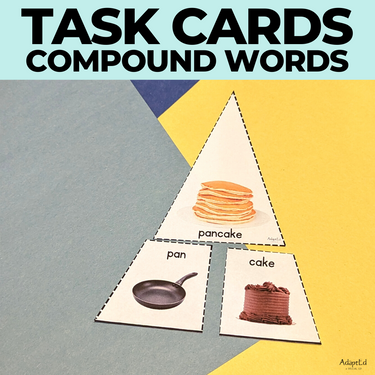
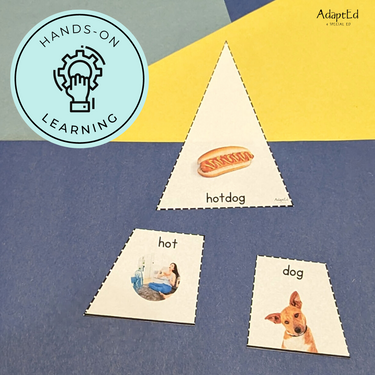
...
$3.97 USD
This set is perfect for special education classrooms and beginning readers who are learning how to read. With 93 compound words included, this set is designed to help children develop their phonemic awareness skills and improve their reading abilities.
Here are some of the benefits of using compound words in special education:
Enhances Phonological Awareness: According to research, teaching compound words can enhance phonological awareness, which is an important skill for early reading development (Barton & Hargreaves, 2018). By breaking down compound words into two parts, children can learn how to identify and manipulate individual sounds in words.
Improves Vocabulary: Learning compound words can also help children improve their vocabulary skills. As they learn about word families and patterns, they can apply this knowledge to other words they encounter in their reading (Cunningham & Stanovich, 1997).
Increases Reading Fluency: When children are able to quickly recognize and decode compound words, it can increase their reading fluency. This means that they can read more smoothly and with greater comprehension (Wolf & Katzir-Cohen, 2001).
Our Building Compound Word Task Cards come in two levels - one with pictures and words and another with just pictures.
This makes it easy for teachers to differentiate instruction based on the needs of their students. The task cards are also versatile and can be used in a variety of ways such as centers, small group instruction or independent practice.
Don't miss out on this must-have resource for your special education classroom!
Order your set of Building Compound Word Task Cards today!
Sources: Barton, D., & Hargreaves, L. (2018). Teaching early reading: Principles and evidence. Sage. Cunningham, A. E., & Stanovich, K. E. (1997).
Early reading acquisition and its relation to reading experience and ability 10 years later. Developmental Psychology, 33(6), 934–945. Wolf M., & Katzir-Cohen T.(2001)
Reading fluency and its intervention Scientific Studies of Reading;5(3):211–39


...
$1.00 USD
Breaking compound words into two parts and writing one of the words down can be helpful in teaching children how to read and write because it helps them learn about word families and patterns.
Level 1: Visual Support + Tracing
Level 2: Writing + Visual Support
Level 3: Writing
9 printable pages included (3 at each level)
This activity also encourages children to focus on the individual sounds within words, which can help them with spelling and decoding unfamiliar words.For non-verbal students and those with intellectual disabilities, learning how to read and write can be a challenge.
However, research has shown that using multisensory approaches can be effective in teaching literacy skills to these students. For example, a study by O'Connor et al.(2019) found that using visual cues such as pictures or gestures along with speech can improve literacy outcomes for students with intellectual disabilities.
In addition, breaking compound words into two parts can be helpful for students who struggle with language development or have difficulty processing information.
By focusing on individual parts of a word rather than the whole word, these students may find it easier to understand the meaning of the word and how it relates to other words.
Overall, practicing CVC words through activities such as breaking compound words into two parts can be beneficial for all early readers, including non-verbal students and those with intellectual disabilities.
It helps develop their phonemic awareness skills while also helping them learn about word families and patterns.
Sources: O'Connor, B., O'Connor, J., & Simon, E. (2019). The effects of a multisensory approach to literacy instruction on the phonological awareness skills of students with intellectual disability. Education and Training in Autism and Developmental Disabilities, 54(1), 20-31.


...
from $29.97 USD
🌟 Unlock the Potential of Twice-Exceptional Learners
They’re gifted. They’re struggling. They don’t fit the mold.This guide helps you support them—without asking them to shrink to fit the system.
The Comprehensive Guide to Twice-Exceptionality gives you expert insight and practical tools to help 2e learners thrive—academically, emotionally, and socially.
👀 What You’ll Learn
✔️ Understand asynchronous development and why 2e students seem inconsistent
✔️ Strength-based strategies for executive functioning and emotional regulation
• How to support students who are gifted in one area but struggling in another
• How to partner effectively with families and support staff
✔️ Real-world case studies, visual tools, and inclusive practices
🙋 Who This Guide Is For
✔️ Teachers supporting gifted students who still struggle
✔️ Parents trying to advocate with limited tools
• Therapists and learning coaches working with complex learners
• Anyone who’s asked: “Why is this still so hard when they’re so smart?”
💬 What Educators Are Saying
“Even after 40+ years in special ed, I learned new strategies.”“This is a wealth of information for parents. For new teachers and practitioners, it is an invaluable guide.”– Denise Abdale (05/22/2024)
📦 Choose Your Format
✔️ PDF – Instant access for quick reference or home printing
✔️ Spiral-bound Print – Ships fast. Ideal for highlighting, flipping, and bringing to IEP meetings
• Australian Orders – Printed and shipped locally within Australia
• Want both? Add both formats to your cart for full flexibility
✍️ Meet the Authors
Shari Bithell, M.Ed, Ed.S – Former GATE teacher and district coordinator. Passionate about executive functioning and 2e inclusion. Brings lived and professional experience to every page.
Jeanine Leech, M.Ed – 24+ years in special education. Former teacher, behavior specialist, director, and advocate. Expert in IEPs, 504s, GATE, and equitable family-school collaboration.
📌 Digital products are delivered instantly. Please purchase additional licenses if you intend to share this resource.


...
$19.97 USD
Ensure that your students get daily practice in the classroom by using these task boxes/task cards/rotation activities!
This set seriously makes core vocabulary AAC practice a no-brainer.
Great for both independent work as well as working with your paraprofessionals.
This is set 1 and it has everything you need to get lots of fun repetitive practice the following core vocabulary words: get, eat, drink, put, happy and sad.
Includes
Get:
Get/Don’t Get: Shopping List Task Bin
Get/Don’t Get: Gift Shopping Task
Get it: Sensory Bins
Eat:
Eat/Don’t Eat: Sorting Task Bin
Eat: Fine motor activity
Drink:
Drink/Don’t Drink: Sorting Task Bin
Put:
Put In: Utensil Sorting Task Bin
Put on: Counting Bears Task Bin
Put In: Recipe Task
Happy/Sad:
Happy/Sad: Emotion ID cards
That’s 10 complete core vocabulary tasks- totaling 98 pages of communication practice!


...
$19.97 USD
Make core vocabulary AAC practice a breeze with these task boxes/task cards/rotation activities.
As an special SLP, I know that it can be a challenge to find ways to incorporate daily practice of core vocabulary words into your students' routine.
Task boxes and task cards are a great way to do just that!
This set includes everything you need to get lots of fun repetitive practice the following core vocabulary words: up/down, open/close, same/different, make/it and who.
Up / Down:
Sorting Task Bin- Students will sort scenes by whether they are going 'up' or 'down' based on the contents of the scene. For example, they will put the girl walking up the starts in 'up' and the man cutting a tree down in 'down'.
Car Driving Task Bin- Supply some toy cars and students drive “Up” or “Down” to each pictured destination. 20 roads with destinations included. *You can also use the phrases “Go up” and “Go down”
Open / Close:
Clothespin Choice Task Cards- Students will match clothespins to the corresponding picture. For example, they will match the clothespin with the picture of a wrapped present to 'open it' and "close it" to the picture of an open unattended refrigerator door.
Open / Close Activity Task Bin- For this task bin you’ll need to gather a few things from around your classroom/ office.
We recommend you choose a variety of small, lidded containers.
This is a dual task- first the student will say “open” as they go through and take the lid off of each container, revealing some small item inside (we like to use small birthday bag toys, or other goodies we can find at the dollar store).
Secondly, they will say “close” as they go back through the containers, this time placing the items back inside and the lids back on.
Open It: Unwrapping Presents- In this activity, students will take turns unwrapping and wrapping presents. presents. To “open” the presents, the student will say “Open it” and then proceed to remove the gift wrapping and find out what’s underneath!
Make It:
Make a Face Task Bin- Students use the phrase “make it” as they choose the face, eyes and mouth to complete each picture.
Choice Making Task Cards- Choice Making Task Cards. Have your student look at the two pictures and decide which one they would choose to make.
Same / Different:
Which One Is different?- In this activity, students will look at three pictures and identify which one is different. For example, they may see three pictures of dogs but one dog may be wearing a collar while the other two are not.
Find The Same- The student looks at a card and finds all of the items that are the
“same.”
These task boxes and task cards are a great way to ensure that your students are getting daily practice with their core vocabulary words.
That’s 11 complete core vocabulary tasks- totaling 104 pages of communication practice! They are also great for working with paraprofessionals!

